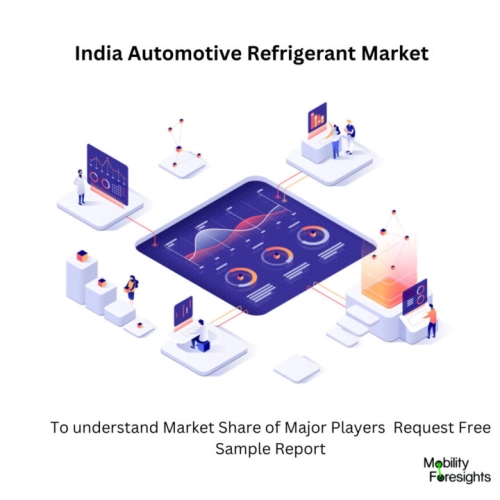
- Get in Touch with Us

Last Updated: Apr 25, 2025 | Study Period: 2023-2030
Air conditioning is now almost standard in automobiles. The F-Gas regulations classify mobile air conditioning for cars (MAC) systems as a separate category because they typically make use of engine-driven compressors and the refrigerant R134a. Split systems made specifically for rail vehicle air conditioning are used.
Each vehicle has at least one distinct system. The compressors used are semi-hermetic piston, hermetic scroll, and small hermetic screw. Compressors can now fit inside roof pods thanks to the development of horizontal scrolls.
In order to maintain passenger comfort in a variety of outside temperature conditions, automobile air conditioning systems operate under varying loads. Temperature stratification in the air stream at the evaporator's exit can be observed under medium operating conditions, which may cause passengers discomfort.
The uneven feeding of the refrigerant liquid phase into the parallel channels of the evaporator from the header's two-phase mixture stream is the root of this issue. The hotter outside air stream could not be effectively cooled solely by the remaining refrigerant vapour flow in channels with a lower inlet liquid flow rate.

The India automotive refrigerant market accounted for $XX Billion in 2022 and is anticipated to reach $XX Billion by 2030, registering a CAGR of XX% from 2023 to 2030.
An automobile evaporative cooler, also known as Solstice yf refrigerancooler, is referred to as a car cooler. Although there are internal under-dashboard or center-floor units with an electric fan that are available, the majority of these relatively inexpensive aftermarket accessories consist of an external window-mounted metal cylinder that does not have any moving parts.
It was an early kind of air conditioner for cars, but it isn't used in modern cars that use refrigeration to cool the interior.
It used latent heat, or cooling by water evaporation, to cool the air. The heat from the air around the device is transferred as the water inside the device evaporates. After that, the cool, humid air is directed inside the vehicle. Because the air is already saturated with water, the "cooling" effect of evaporation decreases with humidity.
As a result, the system performs better in dry desert environments with lower humidity. Car coolers were popular, especially with summer tourists traveling through the states of California, Arizona, Texas, New Mexico, and Nevada in the southwestern United States.
The issue of header two-phase flow maldistribution was addressed. In, a new variant of a branched inlet header was shown. In, a splashing grid and an atomization orifice at the header inlet are shown. In, a solution that involves putting throttle plates inside the header is shown.
The incorporation of evaporator channels into the header also contributed to the improvement. The introduction of flow restrictions in the parallel pipes had a beneficial effect, as shown in. After that, downward-connected 12 inlet and 12 outlet channels in an evaporator's horizontal header are subjected to numerical simulations and analyses of the refrigerant two-phase flows.
The uniformity of the two-phase flow distribution from the header to the evaporating channels has been improved through numerical experiments using a redesigned header.
| Sl no | Topic |
| 1 | Market Segmentation |
| 2 | Scope of the report |
| 3 | Abbreviations |
| 4 | Research Methodology |
| 5 | Executive Summary |
| 6 | Introduction |
| 7 | Insights from Industry stakeholders |
| 8 | Cost breakdown of Product by sub-components and average profit margin |
| 9 | Disruptive innovation in the Industry |
| 10 | Technology trends in the Industry |
| 11 | Consumer trends in the industry |
| 12 | Recent Production Milestones |
| 13 | Component Manufacturing in US, EU and China |
| 14 | COVID-19 impact on overall market |
| 15 | COVID-19 impact on Production of components |
| 16 | COVID-19 impact on Point of sale |
| 17 | Market Segmentation, Dynamics and Forecast by Geography, 2023-2030 |
| 18 | Market Segmentation, Dynamics and Forecast by Product Type, 2023-2030 |
| 19 | Market Segmentation, Dynamics and Forecast by Application, 2023-2030 |
| 20 | Market Segmentation, Dynamics and Forecast by End use, 2023-2030 |
| 21 | Product installation rate by OEM, 2023 |
| 22 | Incline/Decline in Average B-2-B selling price in past 5 years |
| 23 | Competition from substitute products |
| 24 | Gross margin and average profitability of suppliers |
| 25 | New product development in past 12 months |
| 26 | M&A in past 12 months |
| 27 | Growth strategy of leading players |
| 28 | Market share of vendors, 2023 |
| 29 | Company Profiles |
| 30 | Unmet needs and opportunity for new suppliers |
| 31 | Conclusion |
| 32 | Appendix |